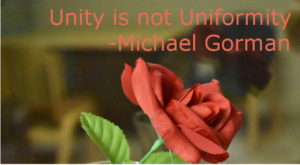Written by Nate Wieland. Media by Cord Buchanan.
What does it mean for the Christian church to be unified? The answer has a lot of nuances and not everybody agrees as to what that looks like. It is nuanced in that we seek unity across a broad spectrum of categories. Racially, culturally, socio-economically, and theologically are just a small sample of the ways in which we seek unity. The answer is highly disputed as well, seeing as how most churches call for, explicitly or implicitly, a certain level of uniformity to their own group identity. As a result, groups with well-defined and rigid identities (denominational, theological, cultural, racial, etc.) may struggle to commune with other rigid groups because they perceive that it would require a sacrifice of at least part of their identity.

Michael Gorman, a new testament scholar, offers a firm rebuttal to this struggle with unity when he says, “Unity is not uniformity.” What he’s saying here is that unity does not require that we all look, speak, think, and act like each other. There is room for disagreement within a body of believers because we aren’t required to be the same. Now, this may run contrary to our initial instincts. Isn’t it important that we in the church believe the same things? Shouldn’t we have the same picture of God? If we don’t all believe the same things about who we’re worshipping, are we even worshipping the same Jesus? These are valid concerns. Luckily, Christians are inheritors of a rich tradition that has dealt with issues of differing belief before. Look at the Bible. We have not one, but four accounts of the life of Jesus! Somewhere along the line, when confronted with multiple gospel accounts, the early scholars of the faith decided that our canon would be most enriched by four accounts of Jesus’ life. Certainly, there were pressures to do otherwise. Marcion, an early church teacher, was tempted to keep only the gospel of Luke as our authoritative Jesus text. Tatian created the Diatessaron, a conglomerate of all four gospels in which he picked out all of the best parts from each and arranged them in a narrative order. A super gospel, if you will. Honestly, these don’t sound like bad ideas. So why then did the Christian community settle on four distinct gospels?
Before we answer that question, it’s important to note the origins of each gospel. Mark was the earliest gospel author, and his work emerged from a predominantly oral culture. Verbal communication was the dominant form of storytelling, so the stories about Jesus were largely passed down by word of mouth. The time between Jesus’ life and the first written records of His life are what is referred to as the oral tunnel. This may have continued, but as Christianity branched out and developed, new needs arose that could be better met with written stories of Jesus. Many of these accounts were single stories, but it was Mark who first endeavored to write a narrative account of Jesus’ life the whole way through. He undoubtedly would have pulled from the various oral (and/or written) traditions swirling around his community, and chose only the stories he saw as most befitting to his intended audience–gentile Christians. In writing this, Mark was intending to strengthen the faith of his community and convey certain important theological ideas. As Mark’s account gained traction in the Christian community, it was spread to surrounding regions for use there as well. In fact, it is from Mark, as well as the Q source (presumably a collection of the sayings of Jesus), that Matthew and Luke based their respective gospel accounts. Using Mark and the Q source, these scholars adapted Mark’s story to fit the needs of their own communities. They cut out certain stories and pasted in others taken from their own tradition, but retained a large percentage of the original literature from Mark. John’s gospel isn’t considered a synoptic gospel because of its vast difference to the other interrelated three. It is speculated that John’s gospel originated in an entirely separate community with different theology and different traditions.

In viewing all of this difference, how did the early Christians see fit to include all four of these gospels? Keith F. Nickle, author of The Synoptic Gospels, states it this way, “Only remarkable openness prevented later Christians from being severely disturbed by the various ways in which the evangelists employed the Jesus stories. Nor were they troubled by the diverse perspectives about Jesus that the several Gospel narratives presented. There was a tolerance in their appreciation that encouraged them to embrace the pluralism of perspectives. They received the differences not as contradictions, but as enriching diversity. So they did not feel compelled to grant exclusive authority to one at the expense of the suppression of the others. While the evangelists intended in some instances to supplant earlier versions, the later church instead related them side by side as enrichingly complementary.” What would it mean for the church today to view our differences as enrichingly complementary? The Gospels give us different portraits of Jesus, so what if we understood our brothers and sisters who were unlike us as giving us another portrait of Jesus? I encourage you to interact with those who are racially, culturally, socio-economically and theologically different than you not as enemies, but as gifts that show to you a new side of Jesus that you maybe have yet to consider. I encourage you as well not to consider this task optional, but as essential in the life of one who desires to know Christ more dearly. Just as we’d miss out on part of Jesus if we were missing a Gospel, so too do we miss out on part of Jesus when we are missing Christians who bring new perspectives.




























